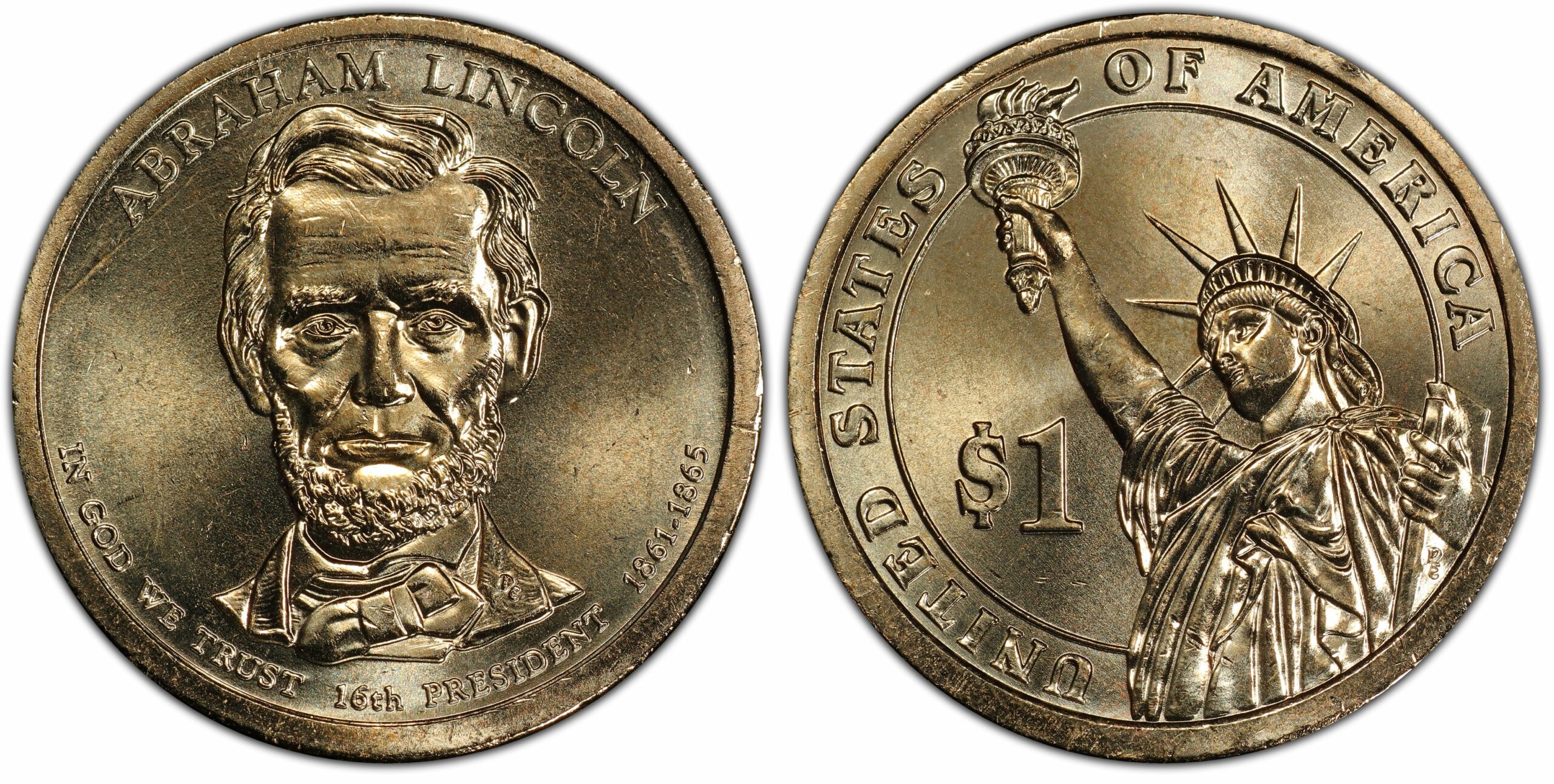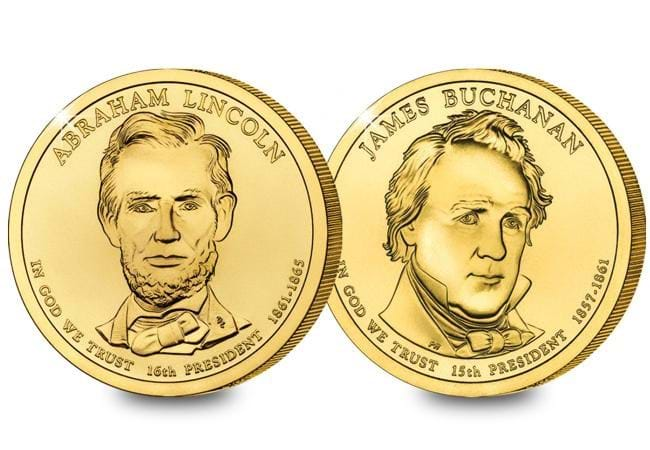The Abraham Lincoln dollar coin is part of the Presidential $1 Coin Program initiated by the United States Mint. This program started in 2007 and produced a series of circulating $1 coins featuring the likeness of each deceased U.S. president in the order they served. What is the Presidential coin collection? What is the Abraham Lincoln Dollar coin?
The Abraham Lincoln dollar coin, the 16th in the series, was first issued in 2010. It features a portrait of President Lincoln on the obverse (front) side, with the Statue of Liberty on the reverse (back) side, which is standard across all coins in this series. On the obverse, the inscriptions “Abraham Lincoln,” “In God We Trust,” “16th President” and “1861-1865” (his term in office) appear.
It should be noted that while these coins are legal tender and can be used for everyday transactions, they have not widely circulated in the general economy and are more typically kept by collectors. They are often available from the U.S. Mint or coin dealers in uncirculated or proof conditions.
As always, when collecting coins, it’s important to consider factors like rarity, condition, and demand in the market to assess their value.
Overview of the Abraham Lincoln Dollar Coin
The Abraham Lincoln Dollar Coin was first introduced in 2010. It was the 16th coin in the series, representing Lincoln’s position as the 16th president of the United States. The coin features a portrait of Lincoln on the obverse (front) side, while the reverse (back) side portrays the Statue of Liberty, which is the standard design for all coins in the Presidential $1 Coin Program.
Key details on the obverse include the inscriptions “Abraham Lincoln,” “In God We Trust,” “16th President,” and “1861-1865,” representing his term in office. The edge of the coin features inscriptions of the year of minting or issuance, “E Pluribus Unum,” and the mint mark.

While these coins are indeed legal tender, they have not been widely circulated for everyday transactions and are more commonly sought after by collectors. They are available from the U.S. Mint in uncirculated or proof conditions and sometimes found in collections or coin shops. The value of these coins, as with any collectible item, can vary depending on their condition, rarity, and the demand among collectors.
Features of the Abraham Lincoln Dollar Coin
While these coins are legal tender, they have not circulated widely for everyday transactions, as the public generally prefers smaller denomination coins and bills. Therefore, they are more commonly seen in coin collections. The value of these coins to collectors depends on factors such as condition, rarity, and demand.
Table of Features
| Feature | Description |
|---|---|
| Obverse Design | Features a forward-facing portrait of President Abraham Lincoln. |
| Obverse Inscriptions | “Abraham Lincoln,” “In God We Trust,” “16th President,” and “1861-1865” (the years he was in office). |
| Reverse Design | Standard design featuring the Statue of Liberty. |
| Reverse Inscriptions | “$1” and “United States of America.” |
| Edge Design | Inscriptions of the year of minting, “E Pluribus Unum,” and the mint mark. |
| Diameter | Approximately 26.5 mm. |
| Material | The outer layer is a mixture of copper, zinc, manganese, and nickel. The core is pure copper. |
| Weight | Approximately 8.1 grams. |
| Use | While they are legal tender, these coins are more commonly collected than used in everyday transactions. |
Note that the value of these coins can vary. Factors like condition, rarity, and market demand play a significant role in their value to collectors. For the most accurate and up-to-date information, consider consulting with a coin dealer or numismatist.
Abraham Lincoln Dollar Coin as an Investment
When considering the Abraham Lincoln Dollar Coin as an investment, several factors need to be taken into account.
Firstly, these coins, while they have a face value of one dollar, are often sold by the United States Mint at a premium to cover manufacturing and distribution costs. Thus, the purchase price is often higher than the face value.
Secondly, the Abraham Lincoln Dollar Coin and other presidential dollar coins are minted in relatively large quantities, which means they are not particularly rare. This can limit their potential for appreciation in value over time.
Thirdly, these coins are made from a combination of metals (copper, zinc, manganese, and nickel), but they do not contain a significant amount of precious metals like gold or silver that might otherwise contribute to their intrinsic value.
Finally, while there is a market for collectible coins, it is somewhat niche. The value of a coin to collectors can be influenced by factors such as condition (coins in uncirculated or ‘mint’ condition are often more valuable), rarity, and demand among collectors.
Therefore, while it is possible that some collectors might pay a premium for a Presidential Dollar coin in excellent condition or for a complete set of the coins, they are generally not considered a traditional “investment” in the same way as stocks, bonds, or precious metals.
As with any investment, it’s recommended that you conduct thorough research or consult with a financial advisor or a coin collecting expert before making a decision. This will help you to better understand the potential risks and rewards associated with investing in collectible coins.
Conclusion
In conclusion, the Abraham Lincoln Dollar Coin, released as part of the Presidential $1 Coin Program, offers both historical and educational value. It serves as a tribute to the 16th President of the United States, featuring a portrait of Lincoln on the obverse side and the Statue of Liberty on the reverse.
However, when considering it as a financial investment, it’s important to note that its value is determined by several factors, including condition, rarity, and market demand among collectors. These coins are not minted in precious metals nor are they particularly rare, which can limit their potential for appreciation over time.
As these coins are more commonly collected rather than used in everyday transactions, their value often exceeds their face value of one dollar, especially for coins in excellent or uncirculated condition. Nevertheless, they are generally not seen as a traditional investment like stocks, bonds, or precious metals.
Always remember to conduct thorough research or consult with a financial advisor or a numismatist before making any investment decisions, to fully understand the potential risks and rewards. Collecting coins can be an enjoyable hobby that also allows you to learn about history and different aspects of numismatics.

